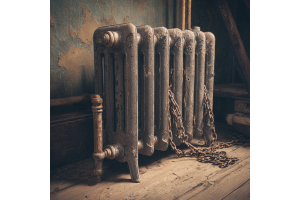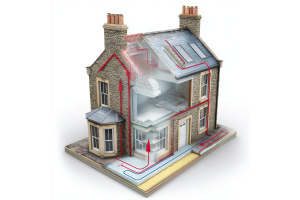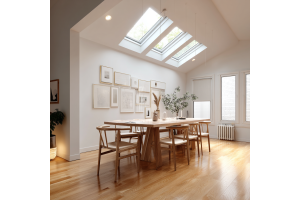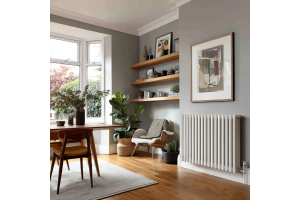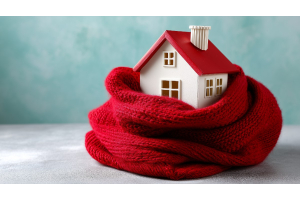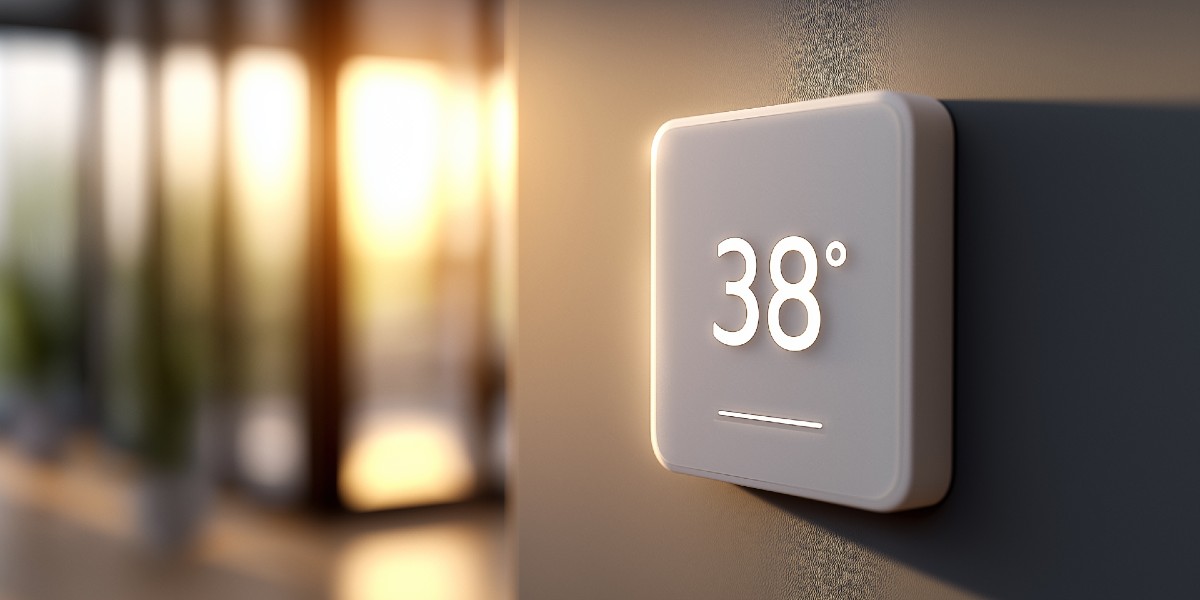
As we move further into the 2020s, the heating industry is rapidly evolving. New technologies, shifting consumer preferences, and mounting environmental concerns are shaping the way we heat our homes and commercial spaces. For 2025, several clear trends are emerging that reflect the demand for smarter, greener, and more efficient heating solutions.
At Geyser.co.uk, we’re excited to share these insights with homeowners, installers, and designers alike to help you stay ahead of the curve when planning your next heating upgrade.
1. The Rise of Smart Heating Controls
Introduction: Heating Gets Smarter
One of the most transformative trends shaping the heating industry in 2025 is the rapid adoption of smart heating controls. Gone are the days when homeowners manually adjusted a single thermostat for the entire home. Today, advanced technology allows for granular control of heating, optimized energy use, and integration with wider smart home ecosystems — all contributing to enhanced comfort, reduced bills, and lower carbon footprints.
At its core, smart heating means using intelligent devices and software to regulate temperature dynamically, learning from user behaviour and environmental data.
Why Smart Heating Controls Are in Demand
-
Energy Savings: Smart controls reduce energy waste by heating only the rooms you use, when you need them. According to studies, smart thermostats can save homeowners up to 20-30% on heating bills.
-
Convenience & Comfort: Remote access via smartphones or voice assistants means heating can be adjusted anytime, anywhere — arriving to a perfectly warm home or turning heat down while away.
-
Environmental Concerns: Lower energy use translates directly to reduced carbon emissions, making smart heating a key player in sustainable living.
-
Integration with Renewable Energy: Smart systems can adapt heating schedules based on solar production or time-of-use tariffs, maximizing green energy use.
-
Government Incentives & Awareness: Increased awareness of energy efficiency and potential subsidies for smart home tech drive adoption.
Key Components of Smart Heating Controls
a. Smart Thermostats
These replace traditional thermostats and connect to Wi-Fi, allowing users to:
-
Set heating schedules easily through apps.
-
Adjust temperatures remotely.
-
Use geofencing to detect when occupants are home or away.
-
Receive energy usage reports and tips for improvement.
Popular models: Nest, Hive, Honeywell Home, Tado.
b. Smart Thermostatic Radiator Valves (TRVs)
TRVs are attached to individual radiators and allow for room-by-room temperature control rather than just central heating regulation. Smart TRVs add wireless connectivity and programmability, enabling:
-
Zoning: heat specific rooms as needed.
-
Integration with smart hubs for automated routines.
-
Voice control via Alexa, Google Assistant, etc.
-
Remote access for temperature adjustments on the go.
Benefits: Avoid overheating unused rooms, reducing energy consumption and improving comfort.
c. Heating Automation & Learning Algorithms
Advanced systems use AI and machine learning to study your daily patterns and preferences, then automatically adjust heating schedules. Features include:
-
Predictive heating — pre-warming rooms before you arrive.
-
Adaptive scheduling — modifying routines based on changing habits or weather.
-
Energy optimization — turning heating off in empty rooms or during warmer days.
d. Integration with Other Smart Home Devices
Smart heating increasingly works within an ecosystem of connected devices:
-
Voice assistants (Amazon Alexa, Google Assistant, Apple HomeKit) allow hands-free control.
-
Smart sensors detect room occupancy or window openings, automatically adjusting heating to avoid waste.
-
Energy management systems optimize usage based on solar panel output or electricity tariffs.
How Smart Heating Controls Work with Existing Radiators
One of the reasons smart heating controls have surged in popularity is their compatibility with existing heating infrastructure. Devices like smart TRVs can be retrofitted onto traditional radiators without the need for a complete system overhaul.
At Geyser.co.uk, we offer a broad selection of smart radiator valves and compatible accessories designed to fit popular radiator models, ensuring an easy transition to a smart heating system.
The Future Outlook: What to Expect in 2025 and Beyond
-
Greater adoption of AI-driven, fully automated heating systems.
-
More affordable, user-friendly smart control kits.
-
Improved interoperability between brands and smart home platforms.
-
Increased integration with renewable energy and grid demand response programs.
-
Wider support for hybrid heating systems combining heat pumps and traditional boilers.
Summary: Why You Should Consider Smart Heating Controls
Switching to smart heating controls isn’t just a trend — it’s a smart investment in energy efficiency, comfort, and future-proofing your home. By giving precise control over where and when heat is used, smart thermostats and TRVs help homeowners save money, reduce environmental impact, and enjoy a more convenient lifestyle.
2. Energy Efficiency and Low-Carbon Heating Solutions
The Growing Importance of Energy Efficiency in Heating
With rising energy costs and increased awareness of environmental issues, energy efficiency has become a critical factor for homeowners and businesses when choosing heating solutions. Heating accounts for nearly half of the average UK household’s energy consumption, so making improvements in this area offers significant cost savings and reduces carbon footprints.
In 2025, energy-efficient and low-carbon heating solutions are no longer optional—they’re fast becoming the standard. The UK government’s net-zero targets and stricter building regulations are pushing consumers and manufacturers towards greener alternatives that deliver comfort without compromising on performance.
What Does Energy-Efficient Heating Mean?
Energy-efficient heating means delivering the required warmth using the least possible energy. This involves several strategies:
-
Efficient Heat Transfer: Radiators and heating systems that warm spaces quickly and retain heat longer.
-
Low Thermal Mass Materials: Components that heat and cool quickly to respond to temperature changes without delay.
-
Zoning and Control: Heating only the rooms that are in use, at the desired temperatures.
-
Reduced Heat Loss: Through improved insulation and properly sealed systems.
-
Integration with Renewable Energy: Using heat pumps or electric heating powered by renewables.
Low-Carbon Heating Solutions: Why They Matter
Heating with fossil fuels like natural gas releases CO₂, a greenhouse gas contributing to climate change. To meet climate goals, homes must shift to heating solutions with lower or zero carbon emissions. These include:
-
Heat Pumps: Air-source and ground-source heat pumps extract heat from the environment and use electricity more efficiently than direct electric heating.
-
Electric Radiators: Especially when paired with renewable electricity sources such as solar panels.
-
Hybrid Systems: Combining traditional boilers with heat pumps to optimise energy use.
-
Efficient Radiators Designed for Low-Temperature Systems: Radiators that perform well at the lower water temperatures used in heat pump systems.
How Radiator Choice Impacts Energy Efficiency
Radiators play a critical role in the overall efficiency of a heating system. The right radiator not only looks good but also transfers heat effectively, working in harmony with low-carbon systems.
Aluminium Radiators: The Efficiency Champion
-
Fast Heat-Up Time: Aluminium radiators respond quickly to temperature changes, meaning less wasted energy warming the unit before heat reaches the room.
-
Excellent Thermal Conductivity: Aluminium conducts heat better than steel or cast iron, resulting in quicker heat transfer and less energy use.
-
Lightweight & Recyclable: Environmentally friendly, with a lower carbon footprint in manufacturing and transportation.
-
Ideal for Low-Temperature Systems: Works efficiently with heat pumps that supply lower water temperatures.
Steel Radiators
-
Good balance of heat retention and efficiency.
-
Heavier than aluminium, slower to respond but can retain heat longer.
-
Suitable for homes with traditional boilers or hybrid systems.
Cast Iron Radiators
-
Known for high thermal mass; they retain heat for a long time even after the heating is off.
-
Less efficient with low-temperature heat sources like heat pumps.
-
Often chosen for aesthetic reasons in period properties.
Zoning and Smart Controls: Maximising Efficiency
The best energy-efficient heating systems incorporate zoning—heating only the rooms that need it, when they need it. This reduces wasted energy and improves comfort.
-
Thermostatic Radiator Valves (TRVs): Allow temperature control for individual radiators.
-
Smart TRVs: Integrate with apps and home automation to adjust heating based on presence, time of day, and weather.
-
Central Control Systems: Manage multiple zones intelligently, learning habits and adjusting to maximise efficiency.
Insulation & System Optimization
No matter how efficient the heating equipment is, without proper insulation and system maintenance, much of that heat escapes.
-
Wall, Roof, and Floor Insulation: Keeps the heat inside, reducing demand.
-
Double or Triple Glazing: Minimizes heat loss through windows.
-
Sealing Draughts: Prevents cold air infiltration.
-
Regular System Servicing: Ensures boilers, pumps, and radiators operate efficiently.
Geyser.co.uk’s Energy-Efficient & Low-Carbon Offerings
At Geyser, we recognise the shift towards energy-conscious heating, which is why we stock:
-
Aluminium Radiators optimised for low-temperature heat pump systems.
-
Smart Heating Controls and TRVs to zone and manage heat efficiently.
-
Electric Radiators designed for use with renewable electricity sources.
-
Accessories like pipe covers and insulation pads to reduce heat loss.
Government Regulations & Incentives Driving Change
The UK government’s Future Homes Standard and Clean Heat Grants encourage homeowners to adopt low-carbon heating. Heat pumps and electric heating systems are incentivised, making efficient radiators and controls more relevant than ever.
Summary: The Path to a Greener, Cost-Saving Heating Future
Energy-efficient and low-carbon heating solutions offer a win-win: lower energy bills and a reduced environmental impact. By selecting the right radiators, controls, and system configurations, you can make your home comfortable, sustainable, and ready for the future.
If you’re planning a heating upgrade, consider aluminium radiators and smart controls from Geyser.co.uk to future-proof your system while enjoying superior performance.
3. Stylish and Designer Radiators
The Evolution of Radiator Design: From Utility to Statement Piece
Traditionally, radiators were purely functional elements—white, bulky, and hidden behind curtains or furniture. However, as interior design trends have evolved, radiators have undergone a transformation. Today, radiators are not just heating devices; they are integral parts of interior aesthetics and style statements.
Homeowners and designers now look for radiators that not only provide efficient heating but also complement and elevate the look of a space. Stylish and designer radiators offer innovative shapes, bold colours, and elegant finishes, making them a focal point rather than an eyesore.
Why Designer Radiators Are in High Demand in 2025
Several factors are driving the rising popularity of designer radiators:
-
Increased Focus on Interior Styling: Modern interiors often feature minimalist or contemporary designs where every detail counts. Radiators have become key design elements.
-
Open-Plan Living: Large open spaces benefit from vertical or sculptural radiators that enhance rather than disrupt visual flow.
-
Smaller Living Spaces: Vertical and compact designer radiators maximize heating capacity without taking up much wall or floor space.
-
Customization: The demand for unique colours, finishes, and shapes has surged as people seek personalized interiors.
-
Multi-Functional Pieces: Some designer radiators double as towel rails or shelving, adding utility alongside style.
Popular Designer Radiator Styles and Features
a. Vertical Radiators
-
Tall and narrow, vertical radiators save horizontal wall space.
-
Available in sleek panels or tubular designs.
-
Perfect for hallways, narrow rooms, or as bold statement pieces.
-
Can be installed in multiple columns or as single slim profiles.
b. Horizontal Designer Radiators
-
Modern panel radiators with clean lines.
-
Often feature low-profile designs with contemporary finishes.
-
Ideal for traditional rooms or under windows.
c. Column Radiators with a Twist
-
Classic column radiators reimagined with unique shapes and metallic finishes.
-
Bring a vintage yet modern vibe.
d. Sculptural and Artistic Radiators
-
Radiators shaped like abstract art, geometric patterns, or organic forms.
-
Designed to be a central feature.
-
Often come in a variety of colours and finishes.
Colour and Finish Trends
Moving beyond the traditional white, the 2025 palette for designer radiators includes:
-
Anthracite Grey and Matt Black: Popular for contemporary, industrial, and minimalist interiors.
-
Metallic Finishes: Brushed chrome, copper, brass, and gold tones add a touch of luxury.
-
Bold Colours: Deep blues, forest greens, and even reds for accent walls or feature areas.
-
Custom Colours: Some manufacturers allow bespoke colours to perfectly match décor schemes.
Benefits of Stylish and Designer Radiators
-
Aesthetic Appeal: Enhance or complement any décor style, from modern to classic.
-
Space Efficiency: Vertical and slimline options free up wall and floor space.
-
Functional Art: Radiators can serve dual purposes—heating and styling.
-
Increase Property Value: Stylish heating solutions can improve the perceived value and appeal of a home.
-
Customization: Tailor-made options make radiators a unique feature.
Popular Brands and Collections Available at Geyser
At Geyser.co.uk, we stock a range of premium designer radiator brands, including:
-
Terma: Known for sleek, minimalist designs and innovative finishes.
-
Lazzarini: Italian craftsmanship combining form and function.
-
Diva Radiators: Stylish vertical and horizontal radiators in multiple colours.
-
Hudson Reed: Offers a wide variety of modern and traditional designer radiators.
These brands offer extensive collections allowing customers to mix style, size, and finish to match any interior.
Installation Considerations for Designer Radiators
-
Wall Strength: Some designer radiators are heavier due to materials or size, so strong wall fixings or floor supports may be needed.
-
Heat Output: Ensure the radiator size and style deliver adequate BTUs for the room.
-
Positioning: Consider design impact and heat distribution; vertical radiators are often placed on narrow walls or hallways.
-
Accessories: Complement designer radiators with matching valves, pipe covers, and brackets for a polished look.
Styling Tips: How to Incorporate Designer Radiators into Your Home
-
Use vertical radiators as focal points in hallways or stairwells.
-
Match radiator colours with other metal accents in the room (lighting, fixtures).
-
Combine with modern furniture to keep spaces clean and minimalist.
-
Choose sculptural radiators for open-plan living areas to add dimension and interest.
-
Use designer towel radiators in bathrooms for both style and function.
The Future of Radiator Design
As technology advances, designer radiators are expected to integrate more smart features seamlessly, combining form, function, and intelligence. Look out for models with built-in smart valves, wireless temperature sensors, and eco-friendly finishes.
4. Increased Adoption of Electric Radiators
Why Electric Radiators Are Gaining Popularity in 2025
Electric radiators have historically been viewed as secondary or emergency heating options. However, in recent years, advances in technology, shifts in energy supply, and changing consumer priorities have propelled electric radiators into the spotlight as a primary, efficient, and flexible heating solution for many UK homes and businesses.
Several factors explain this rising demand:
-
Decarbonisation of the Power Grid: As the UK’s electricity increasingly comes from renewable sources such as wind and solar, electric heating becomes a greener option.
-
Off-Grid and Retrofit Flexibility: Electric radiators do not require connection to gas or wet central heating systems, making them ideal for homes without gas supply or those undergoing phased renovations.
-
Smart Technology Integration: Modern electric radiators often include smart thermostats and app controls, delivering precise temperature management and energy savings.
-
Energy Price Volatility and Alternatives: Some consumers seek electric heating to diversify energy sources, especially as gas prices fluctuate.
-
Simplicity and Lower Installation Costs: Electric radiators require no complex pipework or boiler, reducing installation disruption and upfront costs.
Types of Electric Radiators in Demand
a. Convection Electric Radiators
-
Heat air by convection currents.
-
Provide quick warm-up times and even heat distribution.
-
Suitable for general heating in most room types.
b. Oil-Filled Electric Radiators
-
Contain oil as a heat reservoir.
-
Provide slower, more consistent heat with good thermal retention.
-
Popular for bedrooms or spaces requiring gentle warmth.
c. Panel Electric Radiators
-
Slim, wall-mounted panels often with stylish designs.
-
Heat the room by a combination of convection and radiation.
-
Space-saving and ideal for smaller rooms or flats.
d. Electric Towel Radiators
-
Provide dual functionality—dry towels and heat bathrooms.
-
Increasingly popular in new builds and bathroom refurbishments.
Energy Efficiency Advances in Electric Radiators
Modern electric radiators feature:
-
Thermostatic Controls: Precisely regulate temperature to avoid overheating.
-
Programmable Timers: Schedule heating based on lifestyle patterns.
-
Open Window Detection: Automatically reduce heating when a window is opened.
-
Adaptive Learning: Some models adjust operation based on room use and external weather.
-
Low Standby Power: Minimise energy use when idle.
These features significantly improve efficiency compared to older electric heating models, often rivaling traditional wet central heating in cost-effectiveness when paired with smart controls.
Integration with Renewable Energy Systems
Electric radiators are increasingly integrated into homes with:
-
Solar Photovoltaic (PV) Panels: Excess solar energy can be used to power heating at low marginal cost.
-
Battery Storage: Allows heating to be powered by stored renewable energy.
-
Smart Grid Tariffs: Electric heating can be programmed to operate during off-peak or cheaper energy times.
This integration helps homeowners reduce reliance on fossil fuels and take advantage of greener electricity.
Installation and Flexibility Benefits
-
No Need for Plumbing: Eliminates the cost, disruption, and complexity of installing pipework or boilers.
-
Ideal for Retrofit and Extensions: Electric radiators can be installed individually as rooms or zones are upgraded.
-
Portability: Some electric models are freestanding or wall-mounted but easily relocated.
-
No Flue or Ventilation Required: Important for modern airtight buildings or flats.
Considerations When Choosing Electric Radiators
-
Room Size and Insulation: Proper sizing ensures efficiency and comfort.
-
Power Supply: Check electrical circuit capacity and wiring suitability.
-
Control Compatibility: Ensure electric radiators integrate with existing smart home systems if desired.
-
Aesthetics: Modern electric radiators come in sleek, designer forms to complement interiors.
Geyser.co.uk’s Electric Radiator Range
At Geyser, we stock a variety of electric radiators suitable for diverse needs:
-
Designer Electric Panel Radiators combining style and function.
-
Electric Towel Radiators perfect for bathrooms and en-suites.
-
Smart Electric Radiators featuring Wi-Fi connectivity and app control.
-
Compact Models for small rooms or flats with limited space.
Each product is chosen for quality, efficiency, and reliability, backed by expert advice to help you select the right model.
The Future of Electric Radiators
As technology advances, electric radiators are expected to:
-
Further integrate with smart home ecosystems.
-
Increase use of AI for predictive heating and optimization.
-
Become more efficient with improved insulation and heat distribution technologies.
-
Play a pivotal role in homes transitioning to fully electric, zero-carbon heating.
Summary: Why Electric Radiators Are a Smart Choice in 2025
Electric radiators offer a flexible, efficient, and increasingly eco-friendly heating solution suited to the modern home. Their ease of installation, adaptability to renewable energy, and growing smart capabilities make them ideal for homeowners looking to future-proof their heating while reducing environmental impact.
At Geyser.co.uk, we provide a comprehensive range of electric radiators, accessories, and smart controls designed to meet the demands of today’s discerning buyers.
5. Retrofitting and Hybrid Heating Solutions
The Growing Need for Retrofitting and Hybrid Systems
As the UK’s housing stock ages, many homes still rely on traditional wet central heating systems powered by gas boilers. However, with the push toward net-zero carbon emissions and the increasing adoption of renewable technologies, homeowners and installers are seeking ways to modernize existing systems without costly full replacements.
Retrofitting and hybrid heating solutions provide a practical, cost-effective pathway to upgrade heating systems, combining old and new technologies to improve efficiency, reduce emissions, and enhance comfort.
What is Retrofitting in Heating?
Retrofitting involves upgrading or modifying existing heating systems and components—such as radiators, controls, or pipework—to improve performance and energy efficiency without a full system overhaul.
Key retrofitting upgrades include:
-
Installing smart thermostatic radiator valves (TRVs) to enable room-by-room temperature control.
-
Adding floor stands or new wall brackets to improve radiator stability when moving or upgrading.
-
Replacing old radiators with more efficient aluminium or designer models compatible with low-temperature systems.
-
Upgrading boilers or controls to more efficient or hybrid-compatible models.
Retrofitting helps extend the life of heating infrastructure, reduces waste, and spreads investment costs over time.
What Are Hybrid Heating Solutions?
Hybrid heating systems combine two or more heating technologies to maximise efficiency, comfort, and sustainability. The most common hybrid setup involves:
-
A heat pump (air-source or ground-source) that provides renewable, low-carbon heat.
-
A gas or oil boiler that offers backup or supplementary heating during very cold weather or peak demand.
Hybrid systems intelligently switch between heat sources based on conditions, energy costs, and user preferences, ensuring warmth while minimising carbon emissions and energy bills.
Why Choose Retrofitting or Hybrid Systems?
a. Cost-Effectiveness
-
Full heating system replacements can be expensive and disruptive.
-
Retrofitting allows incremental improvements without major renovations.
-
Hybrid systems enable gradual transition away from fossil fuels, spreading costs over time.
b. Flexibility and Convenience
-
Retrofits can be tailored to specific components, rooms, or functions.
-
Hybrid systems offer flexibility to respond to changing energy prices and availability.
-
Compatible with existing radiators and pipework in many cases.
c. Environmental Benefits
-
Improved controls and radiator efficiency reduce wasted heat and emissions.
-
Hybrid systems significantly reduce carbon footprints compared to traditional boilers alone.
d. Future-Proofing Homes
-
Makes homes compatible with emerging technologies like heat pumps.
-
Supports integration with smart controls and renewable energy sources.
Key Retrofitting Considerations for Radiators
-
Compatibility: Ensure new radiator models or accessories fit existing pipe connections and wall fixings.
-
Weight and Fixings: Retrofitting heavier radiators may require adding or upgrading wall brackets or floor stands.
-
Heat Output (BTUs): Verify upgraded radiators provide adequate heat at the system’s operating temperatures, especially for low-temperature heat pumps.
-
Aesthetics: Select radiators that suit existing interior styles, or opt for designer models to refresh room appearance.
Practical Hybrid Heating Applications
-
Heat Pumps with Existing Radiators: Many aluminium radiators are designed to perform efficiently at lower water temperatures, ideal for heat pump systems.
-
Boiler Backup: The boiler kicks in during peak cold spells, ensuring reliability and comfort.
-
Zoned Heating: Use heat pumps for primary zones (living areas), and boilers for secondary or infrequently used zones.
How Geyser.co.uk Supports Retrofitting and Hybrid Solutions
-
Wide Range of Radiators: Aluminium, steel, and designer radiators compatible with low-temperature systems.
-
Accessories: Wall brackets, floor stands, and valves designed for retrofit projects.
-
Smart Controls: Thermostatic radiator valves and smart thermostats that integrate seamlessly into hybrid systems.
-
Expert Advice: Guidance on selecting products that suit retrofit and hybrid requirements.
Tips for Successful Retrofitting and Hybrid Upgrades
-
Assess Your Current System: Understand existing pipework, radiator sizes, and boiler type.
-
Consult a Professional: Hybrid systems and retrofits can be complex; professional advice ensures compatibility and efficiency.
-
Plan for Controls: Upgrading to smart TRVs and thermostats maximises benefits.
-
Consider Heat Loss: Improving insulation complements any heating upgrade.
-
Phased Approach: Start with controls and radiators, then transition boilers or install heat pumps.
Future Trends in Retrofitting and Hybrid Heating
-
Increasing adoption of smart, AI-driven hybrid systems that automatically optimise energy sources.
-
Enhanced radiator designs tailored for hybrid and low-temperature use.
-
Greater availability of plug-and-play retrofit kits for easier installation.
-
Integration with home energy management systems, solar PV, and battery storage.
Summary: Retrofitting and Hybrid Systems as Practical Solutions for 2025
Retrofitting and hybrid heating solutions represent a sensible, future-ready approach for homeowners looking to improve energy efficiency, reduce carbon emissions, and enhance comfort without the expense and disruption of full system replacements.
By choosing compatible radiators, controls, and accessories from Geyser.co.uk, you can upgrade your heating system smartly, sustainably, and stylishly.
6. Sustainability and Material Innovation
The Increasing Importance of Sustainability in Heating
Sustainability has shifted from being a niche concern to a mainstream priority in the heating industry. As homeowners, builders, and governments focus on reducing environmental impact, sustainable heating solutions are no longer optional—they are essential.
In 2025, consumers want products that not only deliver efficient warmth but also minimize ecological footprints across the entire product lifecycle. This includes manufacturing, installation, use, and end-of-life disposal or recycling.
Key Sustainability Challenges in Heating
-
Carbon Emissions: Heating is a major contributor to household CO₂ emissions.
-
Resource Use: Manufacturing radiators and heating components consumes energy and raw materials.
-
Waste and Disposal: End-of-life radiators and parts can contribute to landfill waste if not recycled.
-
Supply Chain Impact: Transport and logistics add to the carbon footprint.
Material Innovation Driving Sustainability
Aluminium: The Sustainable Choice
-
Recyclability: Aluminium is 100% recyclable without loss of quality, making it one of the most environmentally friendly metals in radiator manufacturing.
-
Lightweight: Its low weight reduces transportation energy and installation strain.
-
Fast Heat-Up & Cool-Down: Aluminium’s high thermal conductivity means quicker, more efficient heating, reducing wasted energy.
-
Longevity: Resistant to corrosion and wear, extending product lifespan.
Steel Radiators
-
Steel is widely recycled and offers good durability.
-
Heavier than aluminium, leading to higher transportation emissions.
-
Advances in manufacturing have improved steel radiator sustainability, including powder-coated finishes that last longer.
Cast Iron Radiators
-
Long lifespan with excellent heat retention.
-
Recyclable but heavy and energy-intensive to produce.
-
Often restored and reused in heritage properties, supporting circular economy principles.
Sustainable Manufacturing Practices
Leading manufacturers now adopt:
-
Renewable Energy: Using solar or wind power in production facilities.
-
Waste Minimisation: Recycling scrap metals and materials during manufacturing.
-
Eco-Friendly Coatings: Low-VOC paints and powder coatings reduce harmful emissions.
-
Water Conservation: Efficient use of water in cooling and finishing processes.
Circular Economy and Product Lifecycle
Sustainability is increasingly measured by how products fit into a circular economy:
-
Design for Disassembly: Radiators designed to be easily dismantled and recycled.
-
Modular Components: Allowing parts replacement rather than full radiator replacement.
-
Refurbishment Programs: Some manufacturers offer radiator refurbishment to extend usable life.
-
End-of-Life Recycling: Encouraging customers to recycle old radiators through take-back schemes.
Sustainable Packaging and Distribution
Reducing environmental impact goes beyond the product itself:
-
Minimal and Recyclable Packaging: Using recycled cardboard and reducing plastic use.
-
Optimised Logistics: Bulk shipping and regional distribution centres to lower carbon footprints.
-
Carbon Offsetting: Some companies invest in carbon offset programs to balance transportation emissions.
How Geyser.co.uk Supports Sustainable Choices
-
Stocks a range of aluminium radiators prioritizing recyclability and efficiency.
-
Partners with manufacturers committed to green production processes.
-
Offers eco-friendly accessories such as insulated pipe covers.
-
Provides information to help customers choose products that reduce energy use and environmental impact.
Future Innovations in Sustainability
-
Smart Heating Integration: Systems that minimize energy waste through precise control.
-
Bio-Based Materials: Exploring coatings and components derived from renewable resources.
-
Advanced Recycling Technologies: Improving material recovery rates.
-
Local Manufacturing: Reducing transport emissions by producing radiators closer to end-users.
Why Sustainability Matters When Choosing Radiators
Choosing sustainable radiators means:
-
Lower energy bills due to efficient heat transfer.
-
Supporting manufacturers who reduce environmental harm.
-
Contributing to global efforts to combat climate change.
-
Enhancing your home’s value with eco-conscious features.
Summary: Embracing Sustainability and Innovation for a Greener Future
In 2025, sustainable heating is about more than just saving energy—it's about choosing materials, manufacturing, and lifecycle processes that protect the planet. By selecting innovative, eco-friendly radiators and accessories from Geyser.co.uk, you take a meaningful step towards a greener, more responsible home.
7. Radiator Placement and Open-Plan Heating Solutions
The Challenge of Heating Open-Plan Spaces
Open-plan living—where kitchen, dining, and living areas flow seamlessly without walls—has become increasingly popular for its spacious, airy feel and social benefits. However, this design style presents unique challenges for heating because large, open areas require thoughtful solutions to achieve consistent, efficient warmth without excessive energy use.
In open-plan environments, heat tends to disperse more freely, and uneven heating can occur, leading to cold spots and discomfort. Therefore, radiator placement and selection become crucial for effective heating.
Key Considerations for Radiator Placement in Open-Plan Spaces
a. Heat Distribution
-
Avoid Concentrating Heat in One Area: In large, open spaces, a single radiator may struggle to adequately heat the entire room. Multiple heat sources spaced strategically ensure even warmth.
-
Consider Airflow: Placing radiators near natural cold points like large windows or external walls helps counteract heat loss.
-
Avoid Obstructions: Furniture or large décor items blocking radiators reduce heat circulation and effectiveness.
b. Zoning and Control
-
Open-plan spaces often include distinct functional zones (kitchen, dining, lounge). Installing thermostatic radiator valves (TRVs) on radiators in each zone allows tailored temperature control, enhancing comfort and saving energy.
-
Smart controls can integrate zoning into automated heating schedules.
c. Radiator Size and Output
-
Larger rooms require radiators with higher heat outputs (measured in BTUs or Watts).
-
Long, low-profile radiators or multiple smaller radiators may perform better than a single oversized unit by distributing heat more evenly.
Types of Radiators Ideal for Open-Plan Areas
a. Horizontal Panel Radiators
-
Wide, low-profile designs that fit beneath windows or along walls.
-
Provide steady, widespread heat suitable for large spaces.
b. Vertical Radiators
-
Tall, slim radiators that save horizontal space.
-
Can be positioned on walls that are less suitable for traditional radiators.
-
Visually appealing and can act as design features in open areas.
c. Linear or Towel Radiators (in Kitchen/Dining Zones)
-
Can provide supplementary warmth and serve as drying racks or towel warmers.
-
Useful in combined kitchen/dining spaces.
Using Multiple Radiators for Better Heat Control
Instead of relying on one large radiator, installing several radiators distributed throughout the open-plan space enables:
-
More consistent heat distribution.
-
Individual control for different zones.
-
Improved energy efficiency by heating only occupied areas.
Integrating Smart Controls for Open-Plan Heating
Smart thermostats and TRVs play a pivotal role in open-plan heating by allowing:
-
Zone-specific temperature management: Each area can have independent heating schedules.
-
Remote access and automation: Adjust heating remotely or set routines based on occupancy.
-
Energy savings: Avoid heating unused parts of the space.
Positioning Radiators to Combat Heat Loss
-
Place radiators on external walls or below windows where most heat loss occurs.
-
Use reflective panels behind radiators to reduce heat loss through walls.
-
Avoid placing radiators behind heavy curtains or furniture that block heat flow.
Other Heating Solutions to Complement Radiators in Open-Plan Spaces
-
Underfloor Heating: Provides gentle, even heat from the floor upwards, great for open areas.
-
Heat Pumps: When paired with efficient radiators, they maintain comfortable temperatures efficiently.
-
Ceiling Fans or Air Circulators: Help distribute warm air more evenly throughout the space.
How Geyser.co.uk Supports Open-Plan Heating Needs
-
Wide range of radiator sizes and styles to suit open-plan zones.
-
Smart TRVs and controls for precise zoning and energy management.
-
Accessories like wall brackets and reflective panels to optimize installation and efficiency.
-
Expert advice to help plan and design the best heating layout for your open-plan home.
Practical Tips for Homeowners and Installers
-
Conduct a Heat Loss Survey: Understand where heat is lost to properly size and position radiators.
-
Plan Zones Carefully: Identify different functional areas to optimize heating control.
-
Avoid Oversizing Radiators: Large, poorly placed radiators waste energy.
-
Use Smart Controls: Maximize comfort and reduce energy use.
-
Consult Professionals: Complex open-plan spaces benefit from expert heating design.
Summary: Effective Radiator Placement is Key to Comfortable Open-Plan Living
Heating large, open-plan spaces requires thoughtful radiator placement, sizing, and control. By strategically positioning multiple radiators, utilizing smart controls, and considering complementary heating methods, you can ensure consistent warmth and energy efficiency throughout your home.
At Geyser.co.uk, we provide the radiators, smart controls, and accessories needed to create perfect heating solutions tailored to open-plan living.
Conclusion: Making the Right Heating Choices for 2025 and Beyond
As we look ahead to 2025, the heating landscape is evolving rapidly—driven by advances in technology, sustainability demands, and changing lifestyles. Whether you’re upgrading an existing system, designing a new build, or retrofitting an older home, understanding the latest trends and options ensures you make informed, future-proof choices.
Key Takeaways
-
Smart Heating Controls have transformed how we manage home warmth, offering unprecedented convenience, efficiency, and integration with smart home ecosystems. Their ability to optimize energy use while enhancing comfort makes them a cornerstone of modern heating systems.
-
Energy Efficiency and Low-Carbon Solutions are no longer just aspirations—they are essentials. Selecting radiators and heating systems that perform well with low-temperature heat sources like heat pumps, and adopting smart zoning, significantly reduce energy consumption and environmental impact.
-
Stylish and Designer Radiators break free from the traditional mold, allowing heating elements to become part of your interior design statement. Today’s radiators combine form and function, giving homeowners more freedom to create beautiful, efficient spaces.
-
Electric Radiators have come a long way. Once seen as secondary heat sources, modern electric models are now highly efficient, smart-enabled, and ideal for homes without gas connections or those looking to integrate renewable energy sources.
-
Retrofitting and Hybrid Heating Solutions provide practical pathways to modernize existing systems incrementally, combining traditional boilers with renewable technologies to balance cost, performance, and sustainability.
-
Sustainability and Material Innovation lie at the heart of the future of heating. Choosing radiators made from recyclable materials like aluminium, supporting manufacturers with green production practices, and focusing on the circular economy helps reduce your home’s environmental footprint.
-
Radiator Placement and Open-Plan Heating Solutions require thoughtful planning to ensure large, open spaces are heated evenly and efficiently. Multiple radiators, smart zoning, and complementary heating technologies ensure comfort and cost savings.
Why Choosing the Right Heating Solutions Matters
Heating is one of the largest energy expenses in a home and a significant source of carbon emissions. By embracing the latest technologies and sustainable materials, you not only save money but also contribute to a cleaner, greener planet.
Choosing the right radiators, controls, and system configurations today means:
-
Greater comfort and control over your living environment.
-
Lower energy bills through improved efficiency.
-
Reduced carbon footprint in alignment with national climate goals.
-
A stylish, modern home that reflects your personal taste.
-
Future-proofing your heating system against regulatory changes and rising energy costs.
How Geyser.co.uk Can Help
At Geyser.co.uk, we are committed to supporting you with:
-
A comprehensive range of radiators—including aluminium, designer, and electric options.
-
Advanced smart controls and accessories for zoning and energy management.
-
Expert advice tailored to your home’s specific heating needs.
-
Products designed with sustainability and innovation at their core.
Whatever your heating project or challenge, we’re here to guide you to the perfect solution that combines efficiency, style, and environmental responsibility.
Final Thought
The future of home heating is smart, sustainable, and stylish. By staying informed and working with trusted experts and quality products, you can ensure your home stays warm, efficient, and beautiful—today and for years to come.



